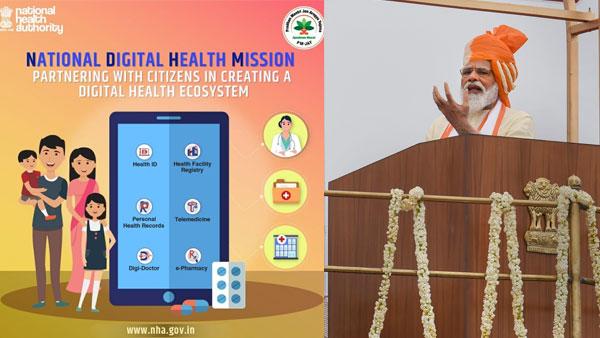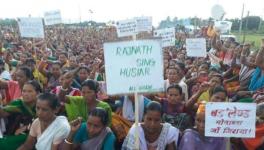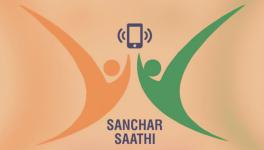NDHM: An All-Out Drive for Privatisation of Healthcare

Image Courtesy: Oneindia
In his Independence Day speech this year, the Prime Minister made a ‘major’ announcement on launching of National Digital Health Mission or NDHM.
“From today, a major campaign is being launched in which technology will play a big role. The National Digital Health Mission is being launched today. This will bring a new revolution in India’s health sector and it will help reduce problems in getting treatment with the help of technology,” the Prime Minister said.
So, what does the NDHM scheme propose to do for citizens’ healthcare?
The NDHM “will reduce existing gaps between various stakeholders, such as doctors, hospitals and other healthcare providers, pharmacies, insurance companies and citizens by bringing them together and connecting them in an integrated digital health infrastructure,” claimed a statement by the National Health Authority (NHA) of AB-PMJAY (Ayushman Bharat-Pradhan Mantri Jan Arogya Yojna), which is the main designer and promoter of NDHM, as advised by government think-tank, of NITI Aayog.
NDHM is planned to be introduced at the first instance in six Union territories -- Andaman & Nicobar Islands, Puducherry, Dadra-Nagar Haveli & Daman and DIU, Lakshadweep, Chandigarh and Ladakh.
The healthcare mission has six parts or six modules for digital interface, i.e. to digitally to see, hear and talk with a patient, or anybody else related to him/her, and other stake holders. There will be two modules of each citizen -- Health ID and Personal Health Records. The other modules include stakeholders, such as DigiDoctor, Health Facility Registry, e-Pharmacy and Telemedicine.
While modules of personal ID, doctor and treatment facility selection will remain with the government, the other three -- Personal Health Records, Telemedicine (for online diagnosis and prescription) and e-Pharmacy (for online supply of medicines, private sector) will be integrated for creating and operating these modules.
“Private stakeholders will have an equal opportunity to integrate with these building blocks and create their own products for the market”, said Indu Bhusan, the NHA chief and its CEO on the launch of the mission.
One interesting nugget of information could help join some dots about which way the mission could be headed. Four days after the announcement of NDHM, the Mukesh Ambani-headed Reliance Industries bought 60% stake in online e-pharmacy Netmeds for Rs 620 crore. “The acquisition gives RIL’s retail unit Reliance Retail entry into a vertical e-commerce space, one of the few that has soared during the COVID-19 pandemic, in addition to its online grocery platform JioMart,” said a report in MoneyControl.
Coming back to NDHM, the hype surrounding it through the mainstream media goes beyond Goebbels’ doctrine of camouflaging real intents. For instance, the Ayushman Bharat project was aimed at converting the government’s role from a ‘Service Provider to a Financier’, as announced by the former Union Health Secretary Sujatha Rao. In effect, however, it has paved the way for insurance companies to provide funds for healthcare with a profit motive, instead of strengthening primary and tertiary infrastructure to provide free and universal healthcare.
Similarly, it is feared that NDHM will help in converting the government’s role from a ‘service provider to a broker’ for the private healthcare sector.
In a nutshell, NDHM is a scheme for (i) privatisation of healthcare system replacing government healthcare services; (ii) promoting ‘e-Pharmacy’ for online supply of medicines and ‘Telemedicine as mode of online diagnosis to digital prescription for the private sector’s benefit and (iii) to keep an individual’s medical history and other details under governmental control, which may well end up being used commercial purposes by the private sector, including during trials for new formulations by multinational drug companies.
Public Healthcare System and Privatisation Drive
The AB-PMJAY was announced by the Prime Minister in his 2018 Independence Day speech and was launched on September 25, 2018. It was a major policy change that completely reversed the healthcare policy of the Central government since Independence.
India’s public healthcare system has evolved out of and remained an important part of the planning process since Indepndence. Health planning was always an integral part of the Community Development Programme. Based on the World Health Organisation’s 1978 Alma-Ata Declaration,‘Health for All by 2000 AD’, India adopted its first National Health Policy (NHP) in 1983, which was replaced by NHP-2002. Added to this were the National Rural Health Mission, 2005 and National Urban Health Mission 2013, which was integrated into the NHM 2013. The Integrated Child Development Scheme or ICDS, and the ASHAs (Accredited Social Health Activist) too have had an important role to play in the public healthcare system.
However, the Narendra Modi-led government replaced NHP-2002 by its NHP-2017, putting healthcare in privatisation mode, lauding the emergence of a private ‘robust healthcare industry’ growing at double digits and to “align the growth of private healthcare sector with public health goals” to “enable private sector contribution to making healthcare systems more effective, efficient, rational, safe, affordable and ethical.”
Data released by the Department of Industrial Policy and Promotion shows that private hospitals and diagnostic centres attracted foreign direct investment (FDI) worth $4.83 billion during 2000-17.
According to the National Family Health Survey-3, the private medical sector remains the primary source of healthcare for 70% households in urban areas and 63% households in rural areas.
The AB-PMJAY served to replace the public healthcare system with and insurance-driven system, the premium of which is being borne by the Central and state governments. In short, the profit motive of insurance companies in the health sector has been neatly aligned with corporates running health facilities (hospitals, nursing homes, diagnostic centres etc.) and private medicine companies.
In this background comes the NDHM, aiming to target mainly those who are outside PM-JAY and proposing to align private doctors, including payment of fees, corporate hospitals and other healthcare providers, like diagnostic centres, pharmacies, insurance companies etc., through its digital platform.
NITI Aayog’s Prescription
On earlier occasions, this writer has pointed how NITI Aayog has assessed the pandemic-induced situation and has drawn a five-point conclusion of promoting (i) work from home (ii) breaking the supply chain from China in India’s and, hence, push for labour reforms, dilute FDI norms and speed up corporatisation and privatisation etc. (iii) it also came to the conclusion that COVID-19 would see a phenomenal rise in ‘Telemedicines’, a euphemism of the patient-doctor-prescription relation through IT and a mechanism to eventually replace the public health services network. and (iv) increasing contactless delivery like e-commerce, e-Pharmacy.
Personal ID & Medical Data
NDHM has two modules– Personal Health ID and Personal Medical Data. Personal Medical Data will be available to private companies, while the government will control the Personal ID data, it has been announced. This means an individual’s medical history and other details will be available to private companies and will be in public domain. The consequences of this are unimaginable, including the use of such data for commercial purposes and its potential for use in trials of new medicines by the MNCs, such as COVID vaccines etc.
On the other side, government control over personal data of citizens, through Health ID, has the potential to be misused for any purpose in times such as the present one.
The writer is a health expert and leader of Centre of Indian Trade Unions. Views are personal. This article was first published on CITU’s Facebook page and has been mildly edited.
Get the latest reports & analysis with people's perspective on Protests, movements & deep analytical videos, discussions of the current affairs in your Telegram app. Subscribe to NewsClick's Telegram channel & get Real-Time updates on stories, as they get published on our website.
























